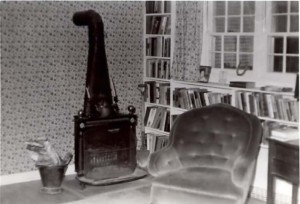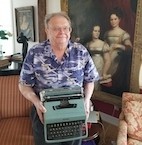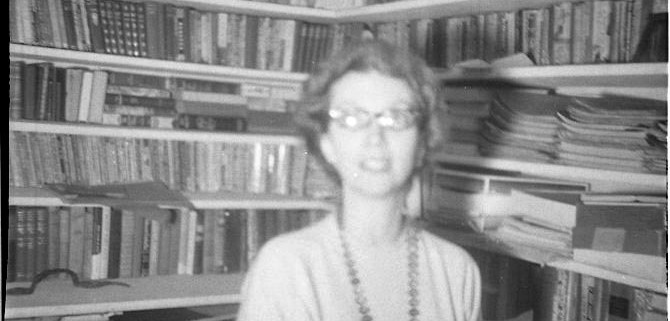A Next Door Neighbor Remembers the Franklins #4
A Tour of the Tower, Part Two
by J. Thomas Allison
Given an empty space the size of a two car garage, sloping walls with headroom of 7 feet, Herb Gubelman worked his creative magic. When you ducked so you wouldn’t hit your head, you found yourself in a most comfortable room. On your left was a door to a “Barbie” size full bath with a toy tub/shower, vanity and commode. On the same wall, which concealed the chimney for a boiler below, he installed a beautiful antique Franklin Stove of elaborate black cast iron and large brass finials. Wonder of wonders, the door could be removed revealing doll house size andirons. There was a little fence to keep tiny burning logs restrained and a woven wire screen to stop sparks.
Best of all, was a real English “fender.” You could push up any one of the oversized overstuffed chairs, put your heels on it and sip a cup of tea. On top of the stove was a little copper tea kettle and small teapot so you could brew it before your eyes.
The south facing sloped roof he raised with a dormer and eyebrow sash windows. Below them, as the roof slanted out anyway, he made an entire wall of bookcases. Every author needs those. Madeleine was to fill them with rows of three ring binders containing onion skin carbon copies of her life’s work.
On the west “A” frame he did the same but installed the three largest sash windows that would fit. From these was a prospect across hay fields sweeping down to woods then the summit of Mohawk Mountain. Throughout the year, every clear evening, without fail, the setting sun filled the room with the last light of day.
Though a large house, there was no place for a guest room. Upstairs were three bedrooms and an odd room made into a kitchen in the 1880’s complete with iron sink. The “Eyrie,” perhaps, might be called into service but only for the young of heart and limb. It had a steep staircase and no facilities were possible.
No problem for Herb. On the sloping north wall, a double bed could be pushed under the eaves. A hinged half wall with sofa cushions made a comfy couch. If you need a guest bed, behind was a little linen closet complete with sheets, blankets and down pillows.
Madeleine brought in her father’s early 19th century partners desk. On this she set an electrified antique student lamp with two

yellow shades. Two corpulent upholstered chairs offered hospitality to the invited and you did not go up there unless invited! The couch offered an ample flat surface for one suffering from the disease of “pernicious horizontal file-itis,” an affliction not solely claimed by authors.
Pushed in the corner between the desk and the sofa was a plain metal typewriter table. Here she set her father’s dark green portable Royal. Shelves behind it held reams of white typewriter paper, tissue thin “onionskin,” envelopes of carbon paper and boxes of typewriter ribbons
In the 1950’s, you had to make your own copies. You could make two if you had a heavy office model and strong touch typing skills. But with a portable, it was one at most, using carbon and the thinnest of second sheets. And….if you made a mistake, it was rolling the packet up and correcting. It always smudged and looked sloppy. If you were careless rolling it back, you would misalign your work. Everything would be overtyped.
The first time only, you undoubtedly would put the carbon in the wrong way and your work appeared in reverse on the back. Accuracy in thought and fingering reduced rewrites and corrections.
Madeleine soon replaced her father’s companion with a baby blue Olivetti. In 1965 she bought an IBM Selectric with the bouncing ball. The feature of this machine was she could replace the fonts with the largest available. Just printing capitals made it easier to read as her eyesight had started to give problems.
She hated the whir of the motor found on all electric typewriters. The foot tapping, arms folded, glaring expression of the unmistakable hum meant you weren’t writing anything!
The table faced into a corner. There was no chance of a distraction from the awesome panorama out the windows. A swivel office chair, probably found cast to the curb in the city, had seen better days forty years ago. Her “cubicle.” was complete.
Her distraction did come from a built in turntable and speaker. There was a sizable collection of long play classic vinyls she called upon while working. The strains of Bach and his buddies behind the shut door at the foot of the stairs was an audible “Do Not Disturb.” If you chanced ascent, the music was replaced by a loud sharp “Get Out.” No polite “please” followed.
Here she was to labor over and give birth to A Wrinkle in Time while in the country. She christened this retreat “The Tower” of course.
 Tom Allison is a retired Congregational Minister living in Albany NY. Rehabbing a house once owned by a Hudson River Steamboat Captain inspired his looking into that history culminating in “Hudson River Steamboat Catastrophes Contests and Collisions” (History Press 2013) available Barnes and Noble and Amazon. Since 5th grade he has enjoyed offering to the public illustrated history lectures. Among the 40 plus have been American Cookbooks, plumbing,, transatlantic steamboat travel in the golden age, Litchfield Connecticut: America’s most historic mile and A neighbor remembers Madeleine L’Engle, (for the 100th anniversary of her birth) to name a few. He is pictured here at Crosswicks, with the typewriter Madeleine gave him on the occasion of his high school graduation.
Tom Allison is a retired Congregational Minister living in Albany NY. Rehabbing a house once owned by a Hudson River Steamboat Captain inspired his looking into that history culminating in “Hudson River Steamboat Catastrophes Contests and Collisions” (History Press 2013) available Barnes and Noble and Amazon. Since 5th grade he has enjoyed offering to the public illustrated history lectures. Among the 40 plus have been American Cookbooks, plumbing,, transatlantic steamboat travel in the golden age, Litchfield Connecticut: America’s most historic mile and A neighbor remembers Madeleine L’Engle, (for the 100th anniversary of her birth) to name a few. He is pictured here at Crosswicks, with the typewriter Madeleine gave him on the occasion of his high school graduation.



